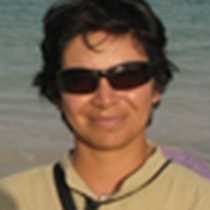Santa Cruz Island
Today we visited the second largest island of the archipelago where we enjoyed the presence of some cooling garua typical of this time of the year. The sun was hiding behind the clouds and we could feel its nice warming rays. Our first outing this morning was to visit the famous Charles Darwin Research Center where we learned about the repatriation program for the giant land tortoises. As we observed the animals in the different corrals, we found Lonesome George enjoying a cooling bath in his private pool while one of his female companions was staring at him from afar. He is the last tortoise from Pinta Island and has been in the breeding center since 1972. Despite much effort he has been coaxed into reproducing. So, he lives on, with two females from a similar population in a nice corral and caring and concerned people looking after him. But when he dies his species will be extinct.
After visiting the Darwin Center we took a stroll along the streets of Puerto Ayora where we supported the economy by buying some of the handcrafts that are made by local artisans. At the end of the morning we drove to the highlands where we dined on delicious lunch on a farm known as El Chato. This wonderful place lies next to the Galápagos giant tortoise reserve. Following lunch we hiked and searched for wild giant tortoises. We found many today! Probably close to thirty in all, and we were happy to find some juveniles along with several huge old males. Finches were plentiful and most of us saw the small tree finch; some of us saw a woodpecker finch!
As we left El Chato we drove higher up the island to visit the endemic forest of scalesias. These small daisy trees are only found in Galápagos. Walking through the forest was like being transported, all of the sudden, to a cloud forest where the trees are covered with mosses, lichens, orchids and small ferns. We were also amazed by an incredible geological formation known as the “gemelos” or pit craters which allowed us to observe several layers of lava from previous volcanic eruptions. Some of those layers were 30 to 40 feet thick.
We left the highlands and drove back to Puerto Ayora in the late afternoon. Some of us returned to the ship, others shopped a little more until the last panga left the dock at 6:00 p.m. We were all happy that our visit to Santa Cruz had been so wonderful and successful, and we are looking forward to tomorrow.
Today we visited the second largest island of the archipelago where we enjoyed the presence of some cooling garua typical of this time of the year. The sun was hiding behind the clouds and we could feel its nice warming rays. Our first outing this morning was to visit the famous Charles Darwin Research Center where we learned about the repatriation program for the giant land tortoises. As we observed the animals in the different corrals, we found Lonesome George enjoying a cooling bath in his private pool while one of his female companions was staring at him from afar. He is the last tortoise from Pinta Island and has been in the breeding center since 1972. Despite much effort he has been coaxed into reproducing. So, he lives on, with two females from a similar population in a nice corral and caring and concerned people looking after him. But when he dies his species will be extinct.
After visiting the Darwin Center we took a stroll along the streets of Puerto Ayora where we supported the economy by buying some of the handcrafts that are made by local artisans. At the end of the morning we drove to the highlands where we dined on delicious lunch on a farm known as El Chato. This wonderful place lies next to the Galápagos giant tortoise reserve. Following lunch we hiked and searched for wild giant tortoises. We found many today! Probably close to thirty in all, and we were happy to find some juveniles along with several huge old males. Finches were plentiful and most of us saw the small tree finch; some of us saw a woodpecker finch!
As we left El Chato we drove higher up the island to visit the endemic forest of scalesias. These small daisy trees are only found in Galápagos. Walking through the forest was like being transported, all of the sudden, to a cloud forest where the trees are covered with mosses, lichens, orchids and small ferns. We were also amazed by an incredible geological formation known as the “gemelos” or pit craters which allowed us to observe several layers of lava from previous volcanic eruptions. Some of those layers were 30 to 40 feet thick.
We left the highlands and drove back to Puerto Ayora in the late afternoon. Some of us returned to the ship, others shopped a little more until the last panga left the dock at 6:00 p.m. We were all happy that our visit to Santa Cruz had been so wonderful and successful, and we are looking forward to tomorrow.



